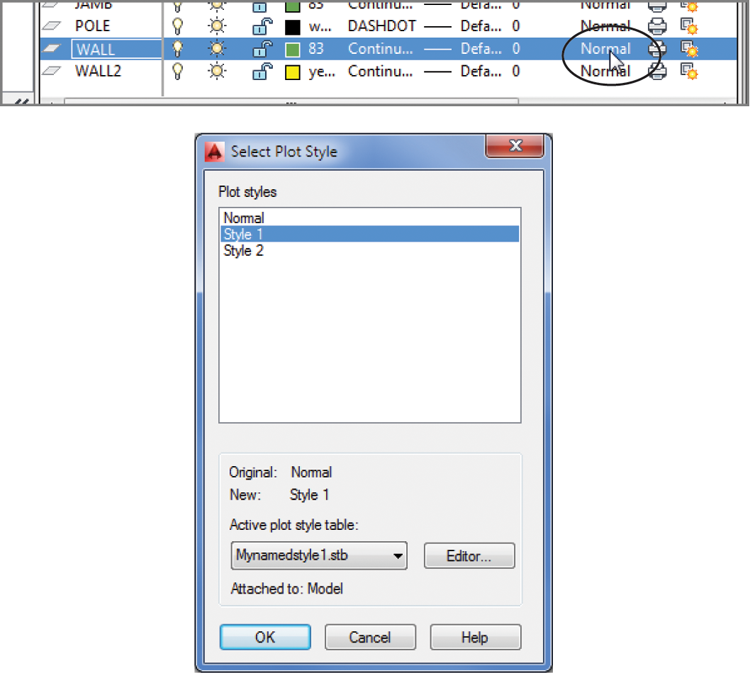Chapter 9
Understanding Plot Styles
To gain full control over the appearance of your output, you’ll want to know about plot style tables. By using plot style tables, you can control how colors are translated into plotted lineweights and how area fills are converted into shades of gray or screened colors in your printer or plotter output. You can also control other aspects of how the plotter draws each object in a drawing.
If you don’t use plot style tables, your plotter will produce output as close as possible to what you see in the drawing editor, including colors. With plot style tables, you can force all the colors to print as black, and you can also assign a fill pattern or a screen to a color. This can be useful for charts and maps that require area fills of different gradations. You can create multiple plot style tables to produce plots that fit the exact requirements of your project.
This chapter will show you firsthand how you can use plot style tables to enhance your plotter output. You’ll look at how to adjust the lineweight of the walls in the Plan file and make color changes to your plotter output.
In this chapter, you will learn to:
- Choose between color-dependent and named plot style tables
- Create a color plot style table
- Edit and use plot style tables
- Assign named plot styles directly to layers and objects
Choosing Between Color-Dependent and Named Plot Style Tables
You can think of a plot style as a virtual pen that has the attributes of color, width, shape, and screen percentage. A typical drawing may use several different line widths, so you use a different plot style for each line width. Multiple plot styles are collected into plot style tables that allow you to control a set of plot styles from one dialog box.
The AutoCAD® 2014 software offers two types of plot style tables: color and named. Color plot style tables enable you to assign plot styles to the individual AutoCAD colors. For example, you can assign a plot style with a 0.50 mm width to the color red so that anything that is red in your drawing is plotted with a line width of 0.50 mm. You can, in addition, set the plot style’s color to black so that everything that is red in your drawing is plotted in black.
Named plot style tables let you assign plot styles directly to objects in your drawing instead of assigning them in a more general way through a color. Named plot style tables also enable you to assign plot styles directly to layers. For example, with named plot styles, you can assign a plot style that is black and has a 0.50 mm width to a single circle or line in a drawing, regardless of its color.
Named plot styles are more flexible than color plot styles, but if you already have a library of AutoCAD drawings set up for a specific set of plotter settings, color plot styles are a better choice when you’re opening files that were created in AutoCAD 2000 and earlier. This is because using color plot styles is more similar to the older method of assigning AutoCAD colors to plotter pens. You may also want to use color plot style tables with files that you intend to share with an individual or an office that is still using earlier versions of AutoCAD.
The type of plot style table assigned to the new default Drawing1 depends on the settings in the Plot Style Table Settings dialog box, which you access through the Plot And Publish tab of the Options dialog box.
You can change the type of plot style table assigned to a drawing. See the sidebar “Converting a Drawing from Color Plot Styles to Named Plot Styles” later in this chapter for more information on plot style conversions.
Here’s how to set up the plot style type for new files:
Figure 9-1 The Plot Style Table Settings dialog box
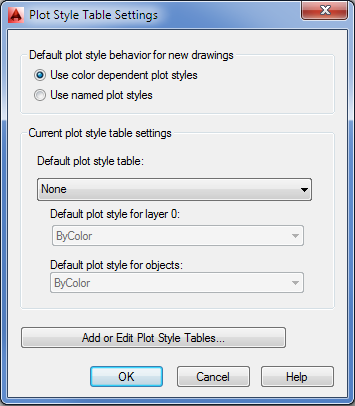
After you’ve set up AutoCAD for color plot style tables, the default Drawing1 file, which appears when you open AutoCAD, will use only color plot style tables. You can change this setting at any time for new files, but after a file is saved, the type of plot style (named or color dependent) that is current when the file is created is the only plot style available to that file. If you need to change a color plot style for a named plot style drawing, see the sidebar “Converting a Drawing from Color Plot Styles to Named Plot Styles” later in this chapter.
Next, you’ll set up a custom color plot style table. Plot style tables are stored as files with the .ctb or .stb filename extension. The tables with filenames that end with .ctb are color plot style tables. The tables with the filename extension .stb are named plot style tables.
Creating a Color Plot Style Table
You can have several plot style table files on hand to apply plot styles quickly to any given plot or Layout tab. You can set up each plot style table to create a different look for your drawing. These files are stored in the Plot Styles folder of the C:UsersUser NameAppDataRoamingAutodeskAutoCAD 2014R19.1enuPlotters folder. Follow these steps to create a new plot style table. You’ll use an existing drawing to learn about the plot style features:
Figure 9-2 Creating a new plot style table
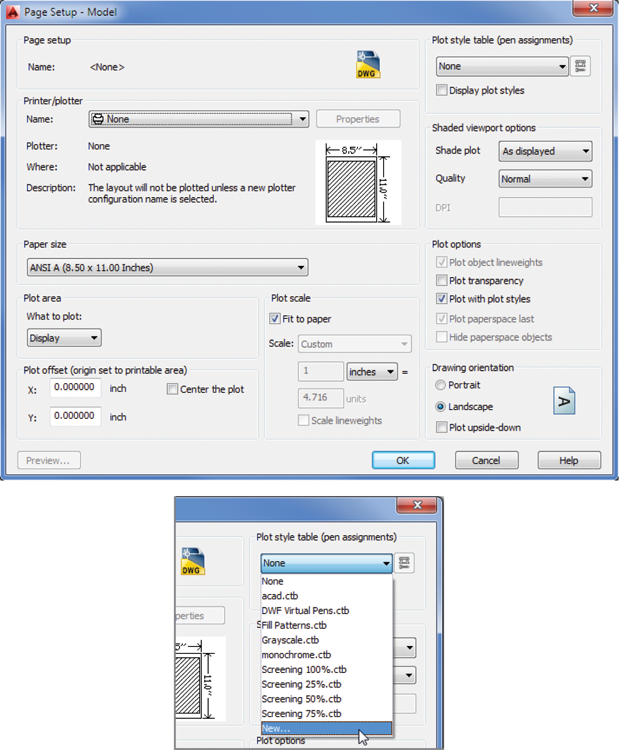
With the Add Color-Dependent Plot Style Table Wizard, you can create a new plot style table from scratch, or you can create one based on an AutoCAD 2000 CFG, PCP, or PC2 file. You can also access the Add Color-Dependent Plot Style Table Wizard by clicking the Plotter Manager tool in the Output tab’s Plot panel. Open the Plot Styles folder, and then double-click the Add-A-Plot Style Table Wizard application. You can also choose Print ⇒ Manage Plot Styles from the Application menu.
The steps shown here are the same whether your drawing is set up for color plot styles or named plot styles.
Editing and Using Plot Style Tables
You now have your own plot style table. In this exercise, you’ll edit the plot style and see firsthand how plot styles affect your drawing:
Figure 9-3 The Plot Style Table Editor, open at the Form View tab
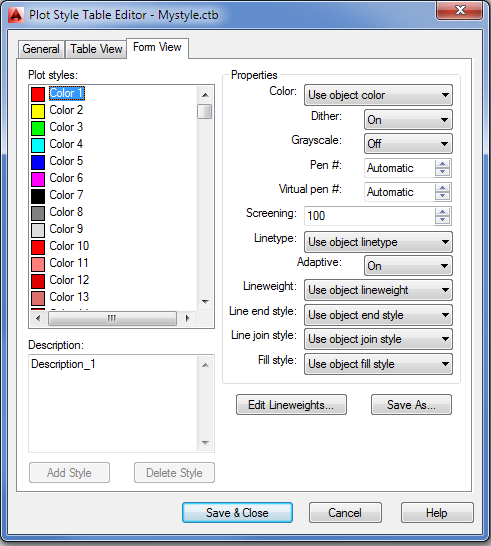
The Plot Style Table Editor has three tabs—General, Table View, and Form View—two of which give you control over how each color in AutoCAD is plotted. The Form View tab lets you select a color from a list box and then set the properties of that color by using the options on the right side of the tab.
The Table View tab displays each color as a column of properties. Each column is called a plot style. The property names are listed in a column to the far left. Although the layout is different, both the Table View tab and the Form View tab offer the same functions.
Now you’ll continue by changing the line width property of the Color 3 (green) plot style. Remember that green is the color assigned to the Wall layer of your Plan drawing.
Figure 9-4 Set the lineweight.
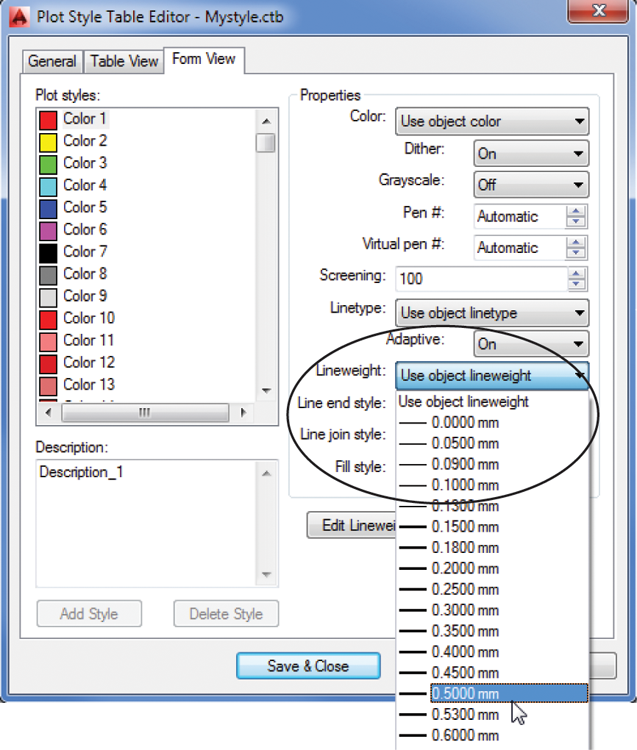
Figure 9-5 Check to display plot styles.
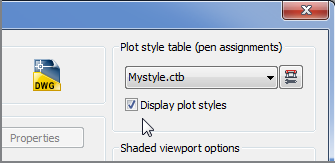
Figure 9-6 Adjust your view to look like this.
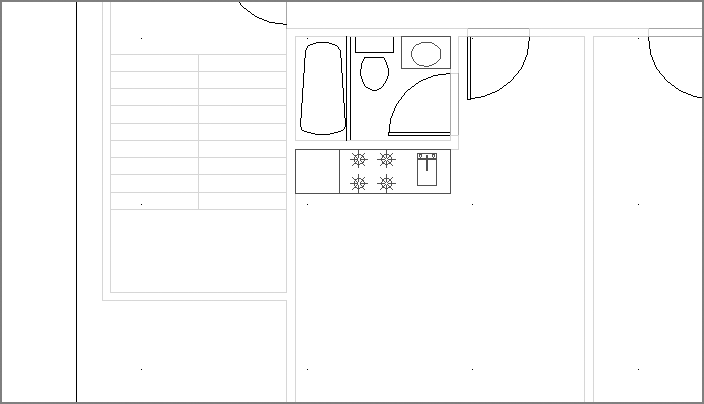
Making Your Plot Styles Visible
You won’t see any changes in your drawing yet. You need to make one more change to your drawing options:
Figure 9-7 Check to show the lineweights.
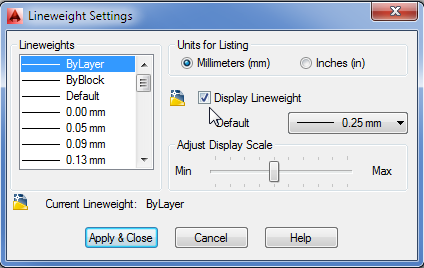
Figure 9-8 The drawing with new lineweight assignments

If your view doesn’t reflect the Plot Style settings, make sure you have the Display Plot Styles option selected in the Plot Style Table (Pen Assignments) group of the Page Setup dialog box.
Making Changes to Multiple Plot Styles
Chances are that you’ll want to plot your drawing in black and white for most of your work. You can edit your color plot style table to plot one or all of your AutoCAD colors as black instead of the AutoCAD colors.
You saw how you can open the Plot Style Table Editor from the Page Setup dialog box to edit your color plot style table. In this exercise, you’ll try a different route:
Figure 9-9 Select Black from the Color drop-down list.
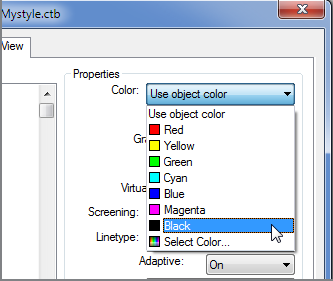
Next, try changing the first nine output colors to black:
Figure 9-10 Select the colors from 1 to 9.
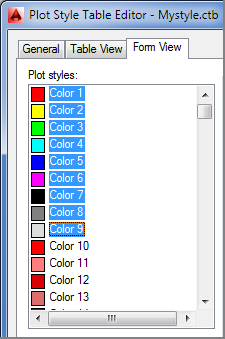
Now when you plot your drawing, you’ll get a plot that is composed entirely of black lines.
These exercises have shown that the Plot Style Table Editor lets you set the color of your printed output to be different from the colors you see in Model Space. In the exercises, you set the plot colors to black, but if you look down the Color drop-down list, you’ll see that you can choose from any number of colors. The Select Color option in the Color drop-down list lets you select colors from the Select Color dialog box (see Figure 9-11). To see the view shown in this figure, make sure the True Color tab is selected and the HSL option is selected in the Color Model drop-down list.
Figure 9-11 The Select Color dialog box
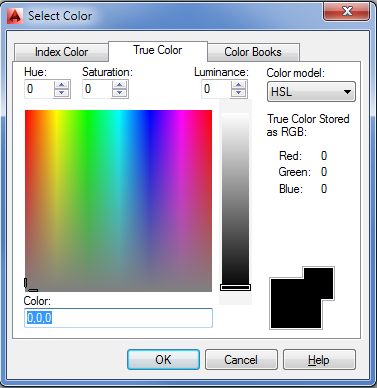
Chapter 5, “Keeping Track of Layers and Blocks,” introduced you to the Select Color dialog box in the context of selecting colors for layers. Here you can use it to assign colors to plot styles. The same three tabs are available: Index Color, True Color, and Color Books. The Index Color tab lets you select from the 255 colors of the standard AutoCAD Color Index (ACI). The True Color tab lets you choose virtually any color you want. The Color Books tab lets you use DIC, RAL, and PANTONE colors.
Setting Up Line Corner Styles
You may notice that the corners of the wall lines appear to be rounded, as shown in Figure 9-12, instead of crisp and sharp.
Figure 9-12 The corners of thick lines may appear rounded.
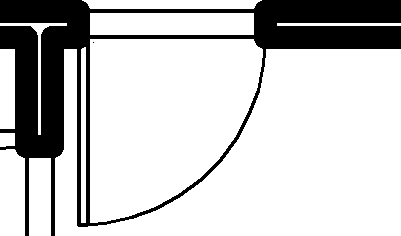
You can adjust the way AutoCAD draws these corners at plot time through the Plot Style Table Editor:
Figure 9-13 Choose square line ends.
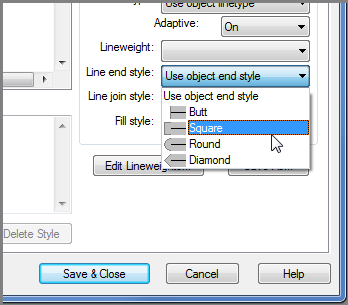
Figure 9-14 The Line End Style setting can alter the way corners are drawn.

The Square option in the Line End Style drop-down list extends the endpoints of contiguous lines so that endpoints merge in a clean corner instead of a notch. The Line Join Style drop-down list offers similar settings options for polylines. For example, you can round polyline corners by using the Round option in the Line Join Style drop-down list.
Setting Up Screen Values for Solid Areas
The last option we’ll look at is how to change a color into a screened area. Frequently, you’ll want to add a gray or colored background to an area of your drawing to emphasize that area graphically, as in a focus area on a map or to designate functions on a floor plan. The settings you’re about to use will enable you to create shaded backgrounds:
Figure 9-15 Select the number 100 in the Screening list box.
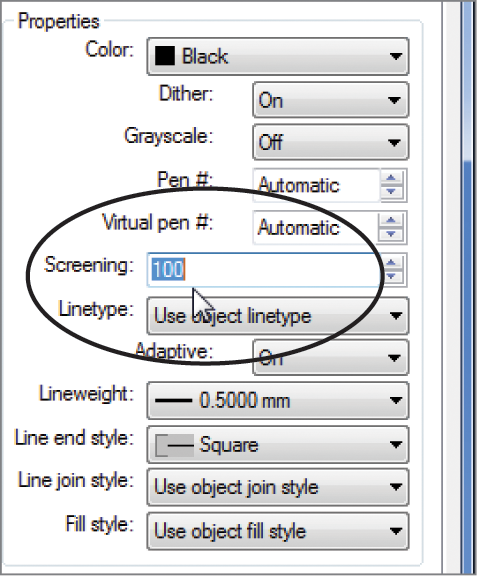
In this exercise, you turned a wide black line into a gray one. The Screening option lets you tone down the chosen color from a solid color to one that has 50 percent of its full intensity.
You can use the Screening option in combination with color to obtain a variety of tones. If you need to cover large areas with color, you can use the Solid hatch pattern to fill those areas and then use the Screening option in the Plot Style Table Editor to make fine adjustments to the area’s color.
Controlling the Visibility of Overlapping Objects
You should also know about the Draworder command in conjunction with solid filled areas. This command lets you control how objects hide or overlap when displayed or plotted. If your solid hatches are hiding text or other graphics, you need to learn about Draworder. See Chapter 14, “Copying Existing Drawings from Other Sources,” for more information. Some output devices offer a Merge Control option that determines how overlapping graphics are plotted. For more information, see Bonus Chapter 3, “Hardware and Software Tips.”
Other Options in the Plot Style Table Editor
You’ve seen a lot of the plot style options so far, but there are many others that you may want to use in the future. The following sections describe those options that weren’t covered in the previous exercises. Be aware that the options in the Plot Style Table Editor are the same regardless of whether you’re editing a color plot style table or a named plot style table.
The General Tab
You may not have really looked at the General tab of the Plot Style Table Editor in the exercise presented earlier. The General tab offers information regarding the plot style you’re currently editing. You can enter a description of the style in the Description box. This description can be useful if you plan to include the plot style with a drawing you’re sending to someone else for plotting.
The File Information group gives you basic information about the file location and name as well as the number of color styles included in the plot style table.
The Apply Global Scale Factor To Non-ISO Linetypes check box lets you specify whether ISO linetype scale factors are applied to all linetypes. When this item is selected, the Scale Factor input box becomes active, enabling you to enter a scale factor. International Organization for Standardization (ISO) linetypes are special linetypes that conform to ISO standards for technical drawings.
The Table View Tab
The Table View tab offers the same settings as the Form View tab, only in a different format. Each plot style is shown as a column, with the properties of the plot style listed along the left side of the tab. To change a property, click it in the column (see Figure 9-16).
Figure 9-16 The Table View tab

To apply the same setting to all plot styles at once, right-click a setting you want to use from a single plot style and choose Copy from the context menu. Right-click the setting again, and then choose Apply To All Styles from the context menu.
Click the Edit Lineweights button to open the Edit Lineweights dialog box, which lets you adjust the lineweight settings for the plot styles.
The Form View Tab
You’ve already seen and worked with the Form View tab, shown in Figure 9-3 earlier in this chapter. This tab contains the same settings as the Table View tab but in a different format. Instead of displaying each color as a column of properties, this tab lists the properties as options along the right side, and the colors are listed in a list box.
To modify the properties of a color, you select the color from the list and then edit the values in the Properties group on the right side of the dialog box. For example, to change the screening value of the Color 3 style, you highlight Color 3 in the Plot Styles list, double-click the Screening input box, and enter a new value.
The names of the properties in the Table View tab are slightly different from those in the Form View tab. The Table View property names are enclosed in brackets in this list.
You’ve already seen what the Screening, Color, Lineweight, and Line End Style options do. Here’s a description of the other style properties. The option names are shown as they appear in the Form View tab with equivalent Table View tab names shown in brackets where they differ:
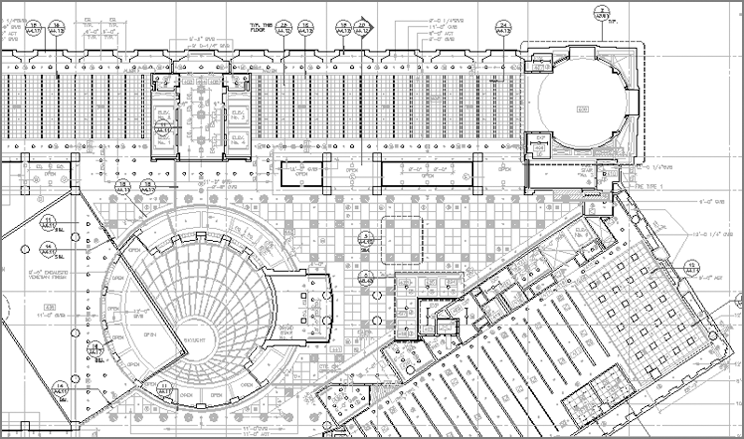
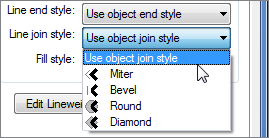
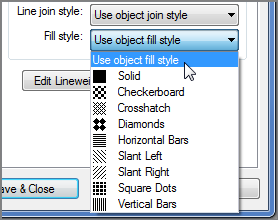
Assigning Named Plot Styles Directly to Layers and Objects
So far, you’ve learned that you can control how AutoCAD translates drawing colors into plotter output. You’ve been using a color plot style table, which assigns a plot style to each color in AutoCAD. You can also assign plot styles directly to objects or layers. To do this, you need to employ a named plot style table. As we said earlier, named plot style tables enable you to create plot styles that have names rather than assign styles directly to colors in AutoCAD. You can then assign a plot style by name to objects or layers in your drawing. In the following sections, you’ll learn how to set up AutoCAD with a named plot style table to assign plot styles to objects; then you’ll create a new plot style table.
Using Named Plot Style Tables
Out of the box, AutoCAD uses the color-dependent plot style table for all new drawings. You can create a new drawing that uses named plot style tables in two ways. The simpler way is to use any of the named plot style template files when you create a new drawing. You’ll see these templates under the Use A Template option in the Create New Drawing dialog box or in the Select Template dialog box (see Figure 9-17).
Figure 9-17 Templates you can choose from
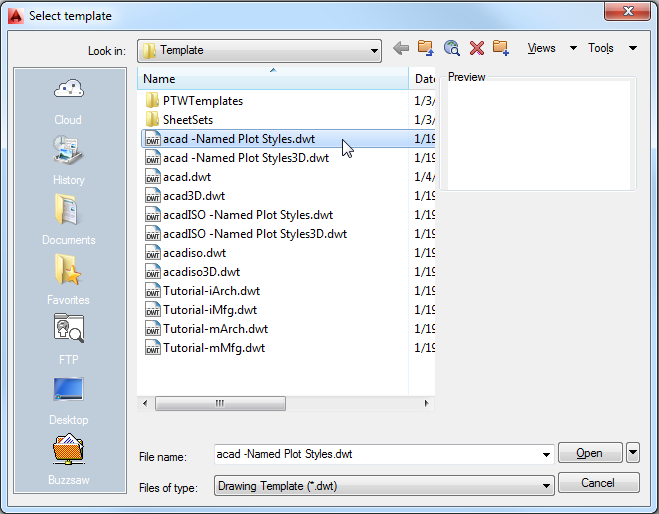
By offering both color and named plot style drawing templates, AutoCAD makes it easy to create and select the type of plot style for your drawing regardless of the current default style.
If you prefer, you can set up AutoCAD to use a named plot style by default when you create a drawing by using the Start From Scratch option in the Create New Drawing dialog box. To set up the default plot style table for new drawings, follow these steps:
Figure 9-18 Select the Use Named Plot Styles option.

To create and try out a new named plot style, you can open an existing file from an earlier version of AutoCAD. In the next few exercises, you’ll use the Plan-named.dwg file. This is a file to which you’ll assign the type of plot style table that is currently the default as determined by the Use Named Plot Styles option you set in the previous exercise. Follow these steps:
Figure 9-19 The Plot Style Table Editor with only one style named
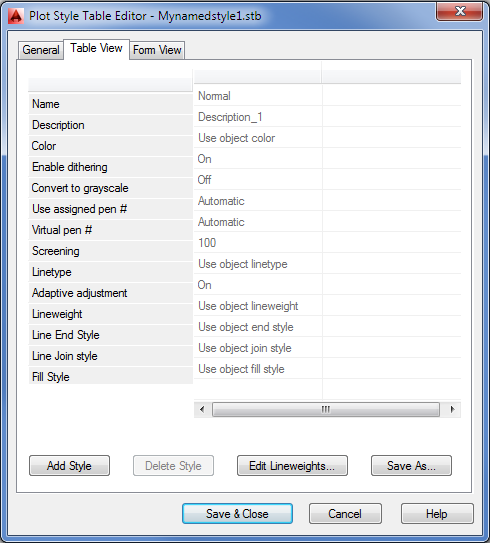
Notice that you have only one style named. Unlike with the color plot style tables, you aren’t assigning a style to each AutoCAD color; you don’t need a style for each of the 255 ACI colors. Instead, you can create a limited set of styles, giving each style the characteristics you want to apply to objects or layers. Continue by adding some plot styles:
Figure 9-20 The Style 1 column appears after you click the Add Style button.
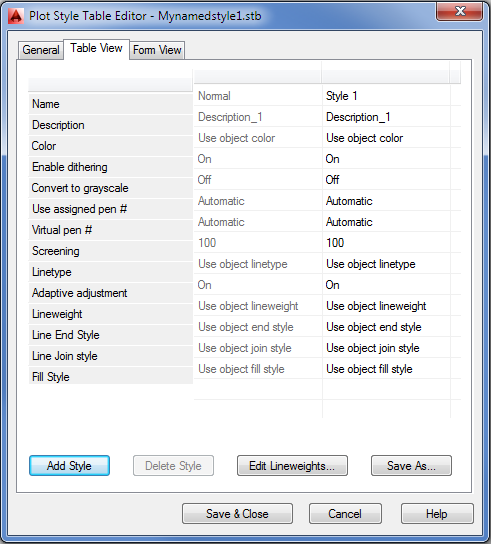
You may have noticed that the Add-A-Plot Style Table Wizard works in a slightly different way when you start it from the Plot Styles window. It adds an extra option (in step 5 of the exercise before the preceding one) that lets you choose between a color plot style table and a named plot style table.
You’ve just created a named plot style. Next, make Mynamedstyle1.stb the default plot style:
Now you’re ready to start assigning plot styles to the objects in your drawing.
Assigning Plot Styles to Objects
After you’ve set up AutoCAD to use named plot styles, you can begin to assign plot styles to objects through the Properties palette. Here are the steps to assign plot styles to objects:
You’ve assigned a named plot style table to Layout1. Note that you can assign different named plot styles to different layouts.
Next, make sure the plot styles will be displayed in the drawing:
Figure 9-21 Select the line shown here.
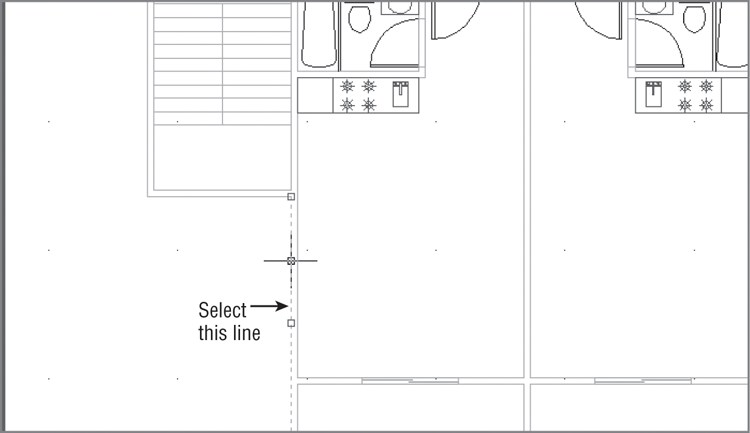
Figure 9-22 Click the Plot Style option to enable the drop-down list.
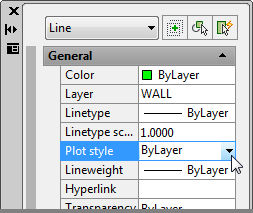
Figure 9-23 The Select Plot Style dialog box

Another way to assign plot styles to individual objects is through the Plot Style drop-down list found in the Home tab’s expanded Properties panel. You may need to select Other from the drop-down list to view all the plot styles.
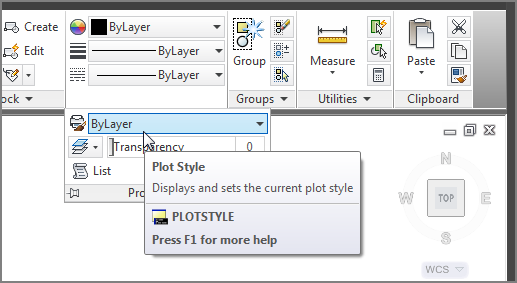
This enables you to select a plot style in a manner similar to how you would use the Layer and Linetype drop-down lists. You can assign plot styles to individual objects by selecting the objects and then selecting a plot style from the Plot Style drop-down list. If you’re using a color plot style table like the one you created in earlier exercises, the Plot Style drop-down list is unavailable.
Assigning Plot Style Tables to Layers
You can also assign named plot style tables to layers. This has an effect similar to using the color plot style tables. The main difference is that with named plot style tables, you assign the plot style tables directly to the layer instead of assigning a plot style to the color of a layer. Here’s how to assign a plot style table to a layer:
Figure 9-24 Assigning a plot style to a layer
